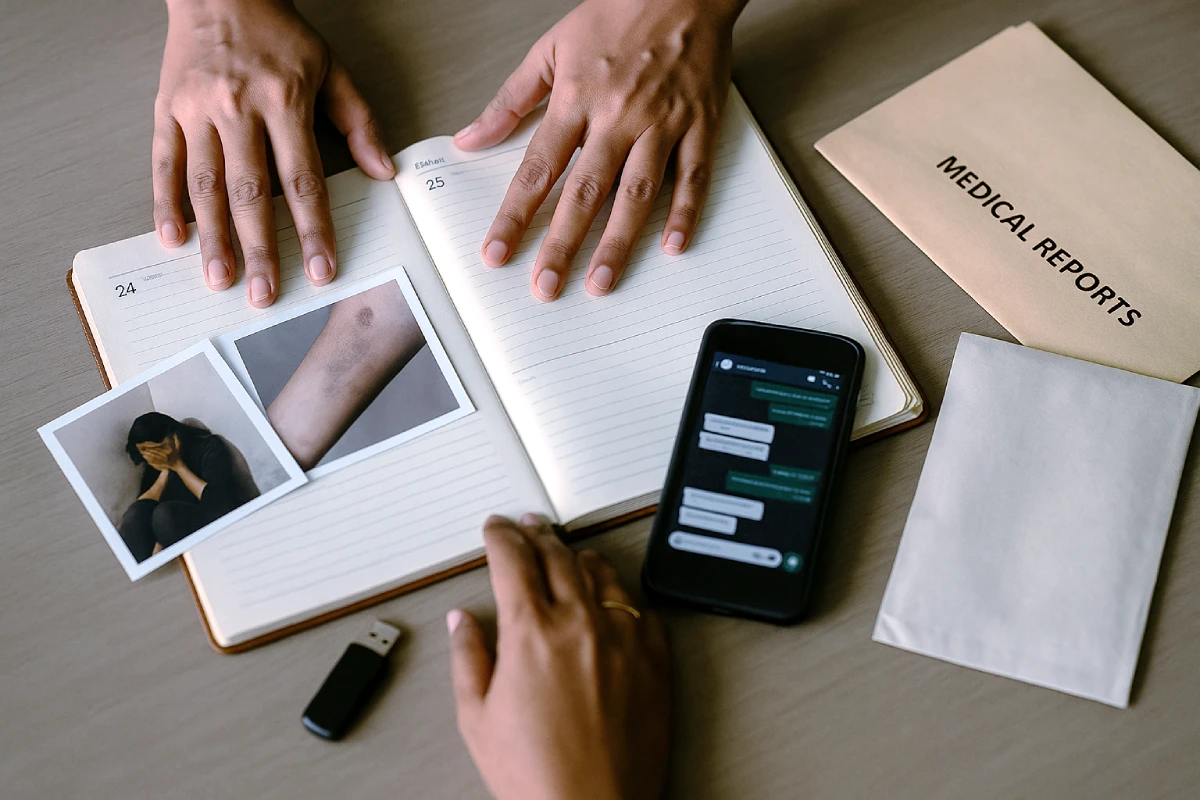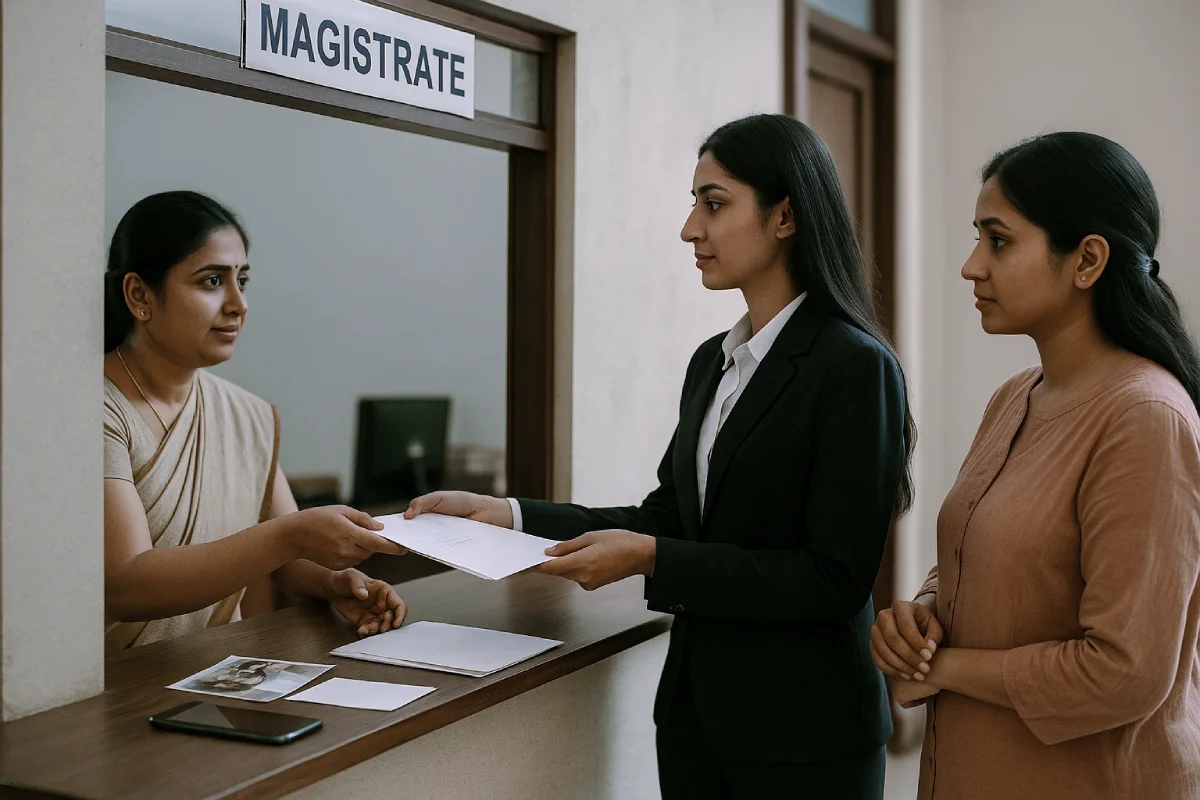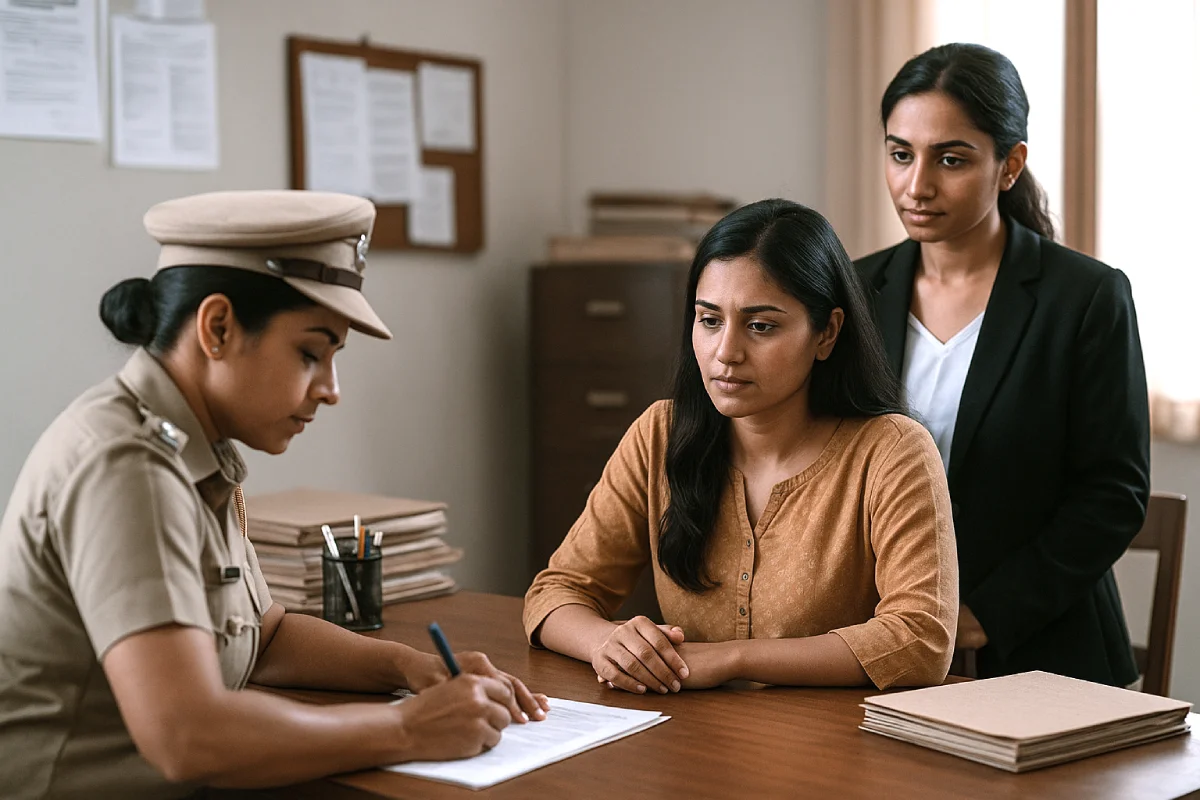What is Domestic Violence in India: Rights & Remedies
A practical, legally accurate guide to help survivors understand domestic violence law in India, preserve evidence, and seek timely civil and criminal remedies, written in plain language and fully compliant with Bar Council of India guidelines.
In this article, you will learn what is Domestic Violence in Indian law, how to recognise it, and the remedies available to you.
How to use this guide
Short, scannable sections explain what domestic violence means in India, immediate safety steps, how to document evidence, and the legal remedies available under the Protection of Women from Domestic Violence Act, 2005 (PWDVA) and the Indian Penal Code (IPC). This article is informational and not legal advice.
What is Domestic Violence in India?
When people ask What is Domestic Violence, the law in India answers broadly: it covers physical, sexual, emotional, and economic abuse. Primary relief comes under the Protection of Women from Domestic Violence Act 2005 (PWDVA), which provides quick protective orders along with residence, monetary, and custody relief.
What is Domestic Violence under the PWDVA (Section 3)
Summary: Section 3 PWDVA defines domestic violence broadly. Abuse may be one act or a pattern.
- Physical abuse: hitting, slapping, kicking, burning, choking, confinement, deprivation of food/medicine.
- Sexual abuse: coerced or non‑consensual sexual conduct; sexual humiliation. Note: While “marital rape” is not a general offence under the IPC (except with a wife under 18), sexual abuse can be grounds for relief under the PWDVA.
- Verbal/psychological abuse: threats, insults, intimidation, humiliation, stalking, isolation, coercive control.
- Economic abuse: restricting access to money, stridhan or necessities; preventing employment/education; disposal of assets or dowry articles.
Who can seek relief, and what is Domestic Violence Against Women
PWDVA remedies are available to an “aggrieved woman” in a “domestic relationship” against a “respondent.”
- Aggrieved woman: any woman alleging domestic violence.
- Domestic relationship: marriage, live‑in relationship “like marriage,” or family relations living together.
- Respondent: adult male/female (post‑2016 amendments and case law) who is a relative/partner in the domestic relationship.
- Live‑in relationships: Relief may be available when the relationship is akin to marriage (see Indra Sarma v. V.K.V. Sarma, 2013). Each case turns on facts such as duration, shared household, social presentation, and financial interdependence.
Civil vs criminal tracks
Survivors often use both tracks.
- Civil (PWDVA): fast, protective, and restorative residence orders, protection orders, custody, monetary relief, compensation.
- Criminal (IPC/CrPC): FIR, investigation, and potential prosecution (e.g., Section 498A cruelty, 323 hurt, 354 sexual assault variants, 406 criminal breach of trust for stridhan, 506 criminal intimidation). Breach of a PWDVA order itself is a criminal offence (Section 31 PWDVA).
Immediate safety steps – Protection of Women from Domestic Violence Act
Prioritise safety. If you are at risk, leave, call emergency services, and get medical care. Do not confront the abuser to “collect proof.”

Emergency contacts and safe exit
Use official helplines; ask for police protection if needed.
- 112 (single emergency), 100 (police), 1091 (women’s helpline), 181 (women’s support). State helplines and One Stop Centres (OSCs) also operate locally.
- If possible, exit to a safe location (family/friends, shelter/NGO). Keep copies of IDs, cash, medicines, keys, and essential devices ready in a discreet “go‑bag.”
Medical attention and MLC
Summary: Injuries, however minor, should be recorded.
- Obtain treatment at a government hospital and request a Medico‑Legal Case (MLC). Ask the doctor to note all injuries and issue copies of reports, prescriptions, and X‑rays.
- Photograph injuries over several days to capture healing stages.
Safety plan
Pre‑plan actions for high‑risk moments.
- Code words with trusted contacts.
- Backup of key data to secure cloud/email.
- Private device access (change passwords, disable location sharing).
- Plan safe routes and times to leave.
Preserve and organise evidence.
Good evidence makes protection faster and more effective. Start a contemporaneous record and store duplicates securely.

Incident log (personal diary)
Create a dated record; short entries are fine.
- Date/time, location, what happened, injuries/damage.
- Names of any witnesses (neighbours, relatives, staff).
Digital evidence
Save, export, and backup.
- Threats/abuse: SMS, WhatsApp, emails, call logs, voice notes; social media posts/messages.
- Financial control: screenshots of bank restrictions, forced transfers, withheld salaries, and set sales.
- Export as PDF or take screenshots with timestamps; email to yourself or a trusted lawyer.
Physical and documentary proof
Keep originals safe; create certified copies when possible.
- MLC/medical papers, prescriptions, imaging.
- Property/tenancy papers, bills, school records (for custody).
- Stridhan list (jewellery, gifts, receipts/photographs).
Approaching authorities
You may file a complaint, seek protection via a Protection Officer, and access free legal aid. If police refuse to register, escalate.
FIR and zero‑FIR
An FIR triggers an investigation.
- Common sections: 498A IPC (cruelty), 323 IPC (hurt), 354 series (sexual assault), 406 IPC (breach of trust for stridhan), 506 IPC (criminal intimidation).
- You may lodge a zero‑FIR at any police station; it must be transferred to the competent station later.
- If refused, write to the Superintendent of Police (Sec. 154(3) CrPC) or file a complaint before the Magistrate (Sec. 156(3) CrPC).
Protection Officers and One Stop Centres
Statutory support exists for coordination.
- Protection Officers (POs) assist with PWDVA applications, service of notice, medical aid, shelter, and police assistance.
- One Stop Centres (OSCs) provide integrated support, counselling, legal aid, temporary shelter, and referral services.
Legal aid
Free representation is available based on eligibility.
- NALSA / State Legal Services Authorities can assign lawyers and cover filing costs in eligible cases.
Civil remedies under the PWDVA, 2005
PWDVA is survivor‑centric. Reliefs can be granted on an urgent/interim basis, even ex parte, to stabilise housing, safety, and finance.

Protection orders (Section 18)
No contact and no violence orders.
- Prohibits violence, threats, stalking, communicating, or visiting the survivor’s workplace/school/home.
Residence rights and residence orders (Sections 17 & 19)
Right to live in the shared household and orders to secure housing.
- The court may restrain dispossession, direct alternate accommodation, or remove the respondent from the shared home.
- Note on case law: S.R. Batra v. Taruna Batra (2007) limited rights in property exclusively owned by in‑laws; later, Satish Chander Ahuja v. Sneha Ahuja (2020) clarified the concept of shared household, permitting residence relief based on factual co‑residence and control, even if the property title lies with in‑laws.
Monetary relief (Section 20) and maintenance
Compensation for expenses and losses caused by abuse.
- Medical, housing, lost wages, and maintenance may be ordered, in addition to relief under Sec. 125 CrPC or personal law statutes.
Custody orders (Section 21)
Summary: Temporary custody/visitation for children’s welfare.
- Orders may require supervised visitation or restrict the respondent if safety risks exist.
Compensation orders (Section 22)
Damages for injuries, including mental torture and emotional distress.
Breach is an offence (Section 31)
Disobeying PWDVA orders is punishable; police can register an FIR for breach.
Procedure notes
Practical pointers for smoother proceedings.
- File Section 12 application before the Magistrate (PO or advocate can assist).
- Seek interim/ex parte relief under Section 23 when urgent.
- Appeals lie under Section 29 (30‑day limitation).
- PWDVA can apply to pre‑Act conduct when effects continue (see V.D. Bhanot v. Savita Bhanot, 2012).
Criminal law options (IPC/CrPC)
Criminal proceedings ensure investigation and potential punishment. Use them where the conduct meets offence definitions or to enforce protection orders.

- 498A IPC – Cruelty by husband/relatives: non‑bailable/cognisable; covers wilful conduct likely to drive a woman to suicide or cause grave injury/harassment for unlawful demand.
- 323/325 IPC – Hurt/grievous hurt.
- 354, 354A‑D IPC – Outraging modesty/sexual harassment/stalking.
- 406 IPC – Criminal breach of trust (often for stridhan retention).
- 506 IPC – Criminal intimidation.
- CrPC 164 – voluntary statement before Magistrate; useful for creating a reliable record.
- Anticipatory bail (Sec. 438 CrPC) and regular bail (Sec. 439 CrPC) apply to accused persons; courts also guard against misuse while protecting genuine survivors (see Rajesh Sharma v. State of U.P., 2017, later clarified in Social Action Forum for Manav Adhikar v. Union of India, 2018).
Divorce, custody, and financial relief
Abuse frequently intersects with family proceedings. Courts prioritise safety and children’s welfare.
Divorce on the grounds of “cruelty”
Summary: Persistent physical or mental cruelty is a recognised ground under Section 13(1)(ia) HMA, 1955.
- Courts have treated sustained harassment as cruelty justifying dissolution (e.g., Shobha Rani v. Madhukar Reddy, 1988; Narendra v. K. Meena, 2016).
Interim support and costs
Financial stability during litigation.
- Section 24 HMA (interim maintenance and litigation expenses) and Section 125 CrPC provide support based on need and means.
Child custody and visitation
Paramount consideration is the child’s welfare.
- Custody/visitation may be restricted or supervised where violence risks are present. Courts evaluate safety, routine, schooling, and the child’s wishes (age‑appropriate). See Vikram Vir Vohra v. Shalini Bhalla (2010) for emphasis on psychological welfare.
Privacy and sensitive hearings
Summary: Courts may conduct in‑camera proceedings in sensitive matters; Family Courts have the flexibility to protect dignity and confidentiality.
Special considerations and practical cautions

Tailor the approach to your facts; avoid common pitfalls.
- During separation, PWDVA relief remains available even if parties live apart; ongoing effects matter (see V.D. Bhanot, 2012).
- Live‑in partners: Remedy depends on whether the relationship is “like marriage” (Indra Sarma, 2013).
- False or exaggerated allegations: Accused persons may seek anticipatory bail, quashing under Sec. 482 CrPC, or rebut through documentary evidence. Courts balance misuse concerns while safeguarding victims.
- Mediation & settlements: Civil PWDVA reliefs may be settled; for 498A, compounding requires High Court quashing of FIR under Sec. 482 CrPC (Gian Singh v. State of Punjab, 2012).
Quick checklists
Use these bite‑sized lists when time is short.
Evidence starter kit
- Incident diary: date/time, what happened, witnesses.
- Photos of injuries/damage over several days.
- MLC/medical papers; prescriptions; imaging.
- Threat messages, call logs, emails, and bank proof of economic abuse.
- Stridhan list with photos/receipts.
FIR essentials
- Full facts (who, what, where, when, how) and prior incidents.
- Identify applicable sections (498A/323/354/406/506 IPC).
- Attach copies of MLC, photos, and messages if available.
- Request an acknowledgment copy and the FIR number.
Court‑day pack
- ID proof, copies of pleadings, evidence set, list of reliefs sought.
- Emergency contacts, transport plan, support person.
FAQs
What is Domestic Violence?
It is any physical, sexual, emotional, or economic abuse in a domestic relationship. Indian law defines it broadly under Section 3 of the PWDVA and offers quick civil protection along with support services.
Can I seek help under PWDVA and also file an FIR?
Yes. PWDVA reliefs (civil) and IPC offences (criminal) run in parallel. Many survivors pursue both to maximise safety and accountability.
Do I lose my residence rights if the home is in my in‑laws’ name?
Not necessarily. Courts look at whether it is a shared household (co‑residence, control, matrimonial home). Ahuja (2020) broadened the approach beyond the narrow reading in Taruna Batra (2007). Facts matter.
Can a man file under the PWDVA?
The PWDVA is gender‑specific to women. Men alleging abuse may use general criminal/civil laws (e.g., 323/506 IPC, family law remedies).
I left the house years ago. Can I still apply?
Often, yes. Continuing effects and ongoing deprivation can justify relief; courts have allowed applications even for pre‑Act conduct where effects persisted (V.D. Bhanot, 2012).
How fast can I get protection?
Courts can grant ex parte interim protection under Section 23 PWDVA when urgent. Timelines vary by court load and case facts.
Will domestic violence affect alimony/custody?
Courts consider proven violence while deciding maintenance and custody/visitation, with the child’s best interests as the overriding test.
Disclaimer: Information only not a substitute for tailored legal advice. If you are in danger, call 112/100 immediately or approach the nearest police station/One Stop Centre.
Need Legal Assistance?
If you or someone you know is facing domestic violence, it’s important to act quickly and protect your rights. Our experienced legal team can guide you through protection orders, evidence gathering, and both civil and criminal remedies under Indian law. Contact us today for confidential assistance.
Call us or fill out our online form to schedule a consultation. Your safety and rights are our priority.







